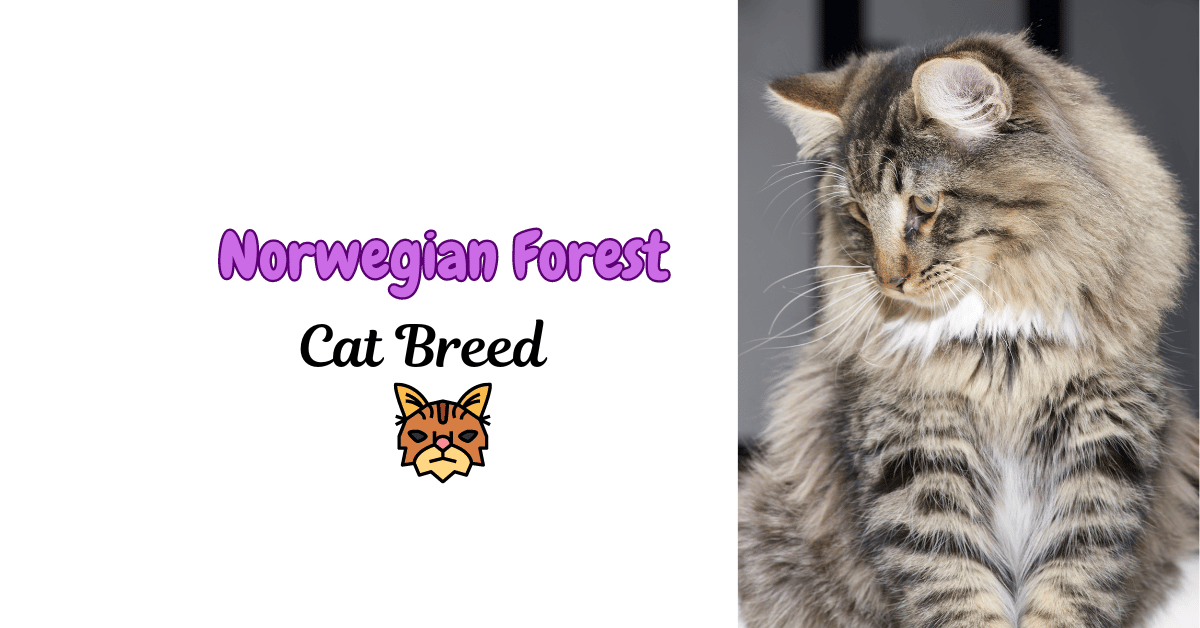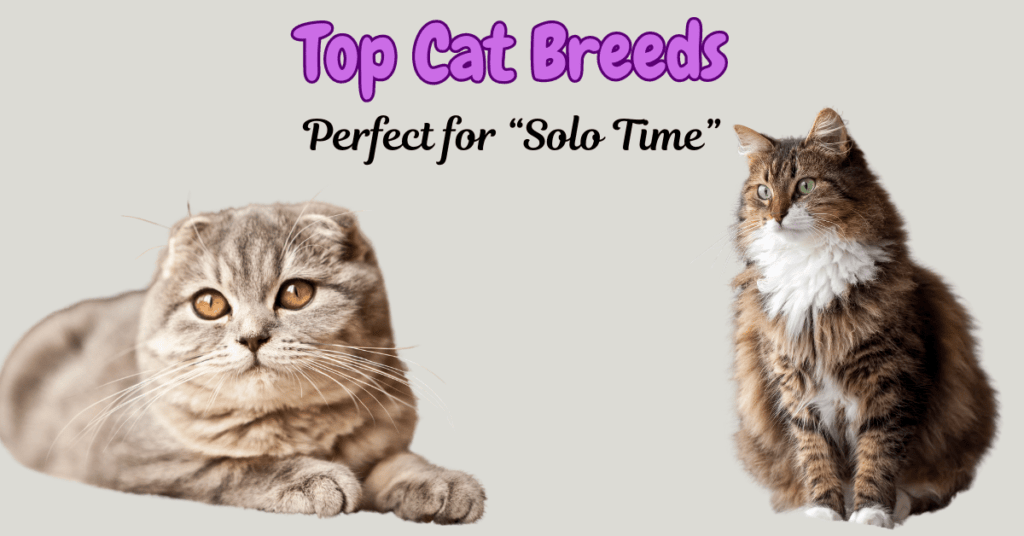This post contains affiliate links and I will be compensated if you make a purchase after clicking on my links.
Introduction: Meet the Norwegian Forest Cat Breed
Welcome to the enchanting world of the Norwegian Forest Cat Breed, a majestic feline that combines rugged beauty with a splash of royal charm. Known affectionately as “skogkatt” in its native Norway and “wegie” in the U.S., this breed boasts a long, dense coat that shields it from the chill of Nordic forests.
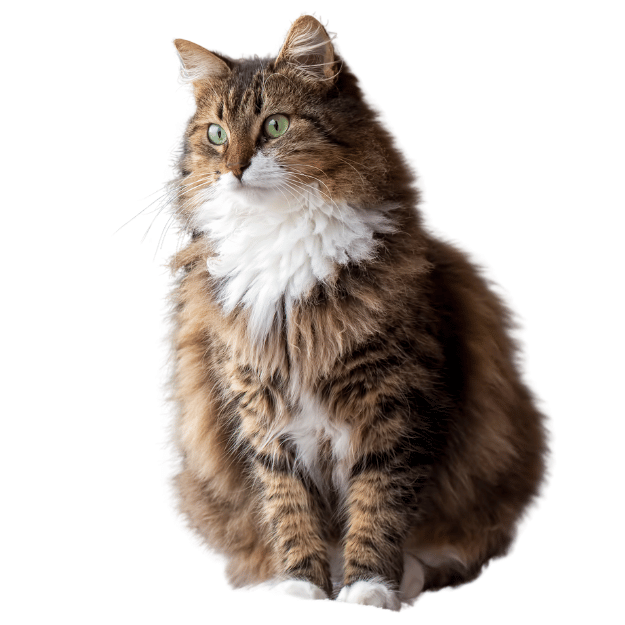
Not just any ordinary cat, the Norwegian Forest cat holds the prestigious title of Norway’s official cat, a recognition bestowed by King Olav V in the 1950s.
Renowned for their calm and affectionate demeanor, these cats aren’t just about looks—their double coats are so effectively waterproof that they are nearly impervious to moisture.
Origin: The Viking Cats of Norway
The storied past of the Norwegian Forest Cat Breed stretches back to the era of the Vikings. Around A.D. 1000, these seafaring warriors are believed to have brought with them a landrace of short-haired cats to Norway, along with long-haired breeds akin to the modern Siberian, Turkish Angora, and Maine Coon.
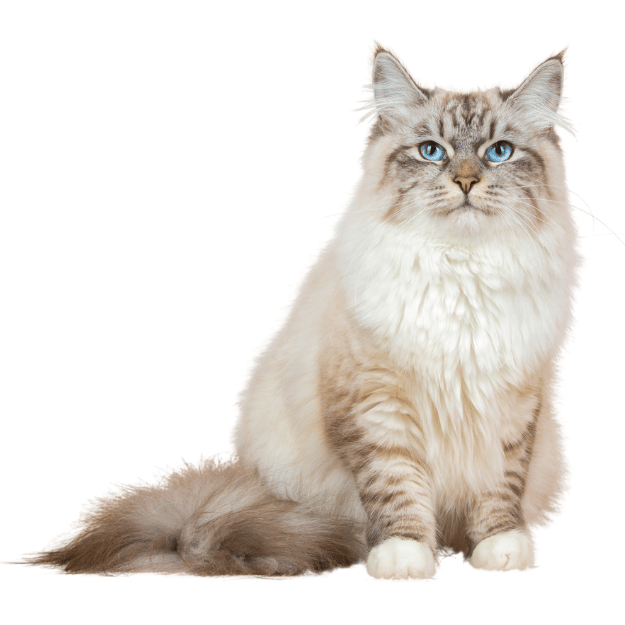
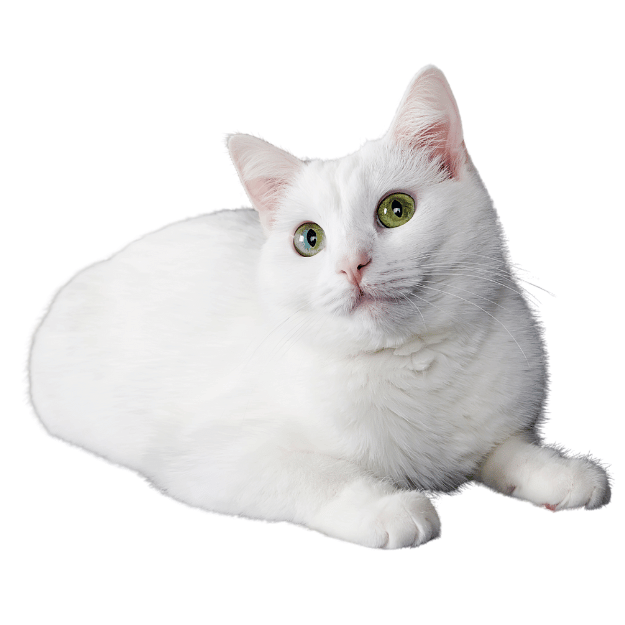
These early ancestors paved the way for what would become a distinctive lineage, identifiable as early as the 16th century through various depictions and writings.
Despite their near brush with extinction due to widespread
crossbreeding at the turn of the 20th century, national pride rekindled interest in the breed. In a pivotal move in 1938, King Olav V officially declared the Norwegian Forest cat as the national cat of Norway, reinforcing its significance as a national treasure.
Through dedicated breeding efforts, enthusiasts have not only revitalized the breed but have also helped it to flourish across continents. The first Norwegian Forest cats set paws in the United States in 1979, achieving championship status with The International Cat Association by 1984 and later with The Cat Fanciers Association in 1993.
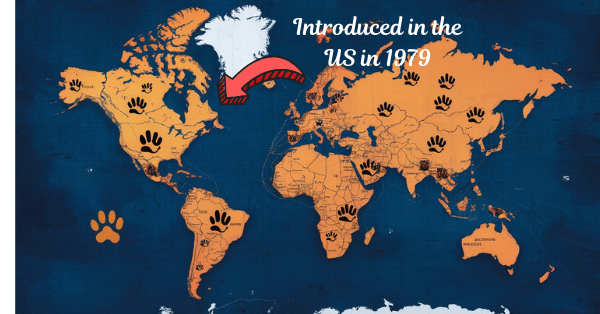
Norwegian Forest Cats aren’t just a part of Norway’s natural history—they’re woven into its cultural folklore as well. Legend has it that Freya, the Norse goddess of love and beauty, chose these robust cats to pull her chariot, underscoring their divine stature within Norse mythology.
Physical Characteristics: The Hardy Norwegian Forest Cat Breed
Key Traits and Size
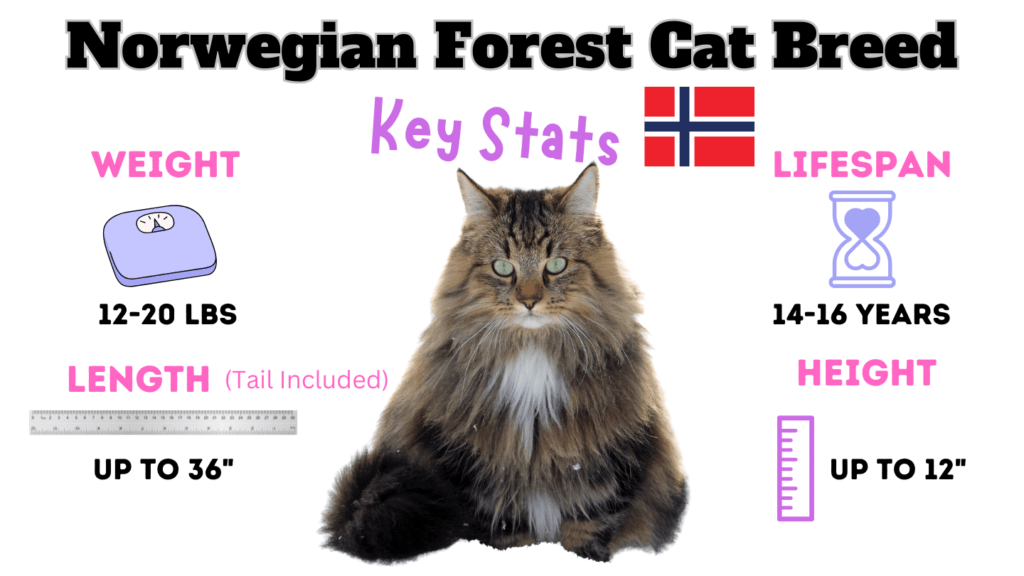
The Norwegian Forest Cat Breed is one of the larger breeds, with males typically weighing up to 20 pounds and females around 12-15 pounds. They can stretch up to 36 inches in total body length, including the tail, showcasing their impressive size and stature.
Their muscular build and substantial bone structure give them an appearance as if they’ve just emerged from the forest. Despite their robust build, these cats mature slowly, usually reaching full size around five years of age.
Distinctive Body Features
The head of the Norwegian Forest Cat is distinctively shaped like an equilateral triangle, complete with strong chins and medium-length muzzles. Deviations from this shape are considered defects. Their eyes are almond-shaped and oblique, which may be any color, adding to their mystical allure.
The breed’s distinctive leg structure, with longer hind legs, elevates their rump higher than their shoulders, contributing to their unique silhouette. The ears are wide at the base, rounded at the tips, and heavily furred. Lynx-like tufts on the ears are highly desirable and a hallmark of the breed’s rugged charm.
Coat and Color
The Norwegian Forest Cat features a specialized double coat that’s essential for survival in harsh winters of Scandinavia. The outer layer is robust and water-resistant, sporting a pronounced ruff around the chest, a fluffy collar at the neck, and protective britches on the rear legs.
Their bushy, tufted tails and heavily tufted toes make them adept at navigating the frosty landscapes. These cats display a vibrant array of coat colors and patterns, from solids and bi-colors to complex designs like tabby, tortoiseshell, calico, and smoke.
Pro Tip: Norwegian Forest Cats do not exhibit colorpoint coats, but they often feature popular tabby markings that echo their wild heritage. Their color palette is equally diverse, including eye-catching shades of green, gold, green-gold, copper, and blue, which are particularly stunning in cats with white or partially white fur.
Personality Traits of The Norwegian Forest Cat
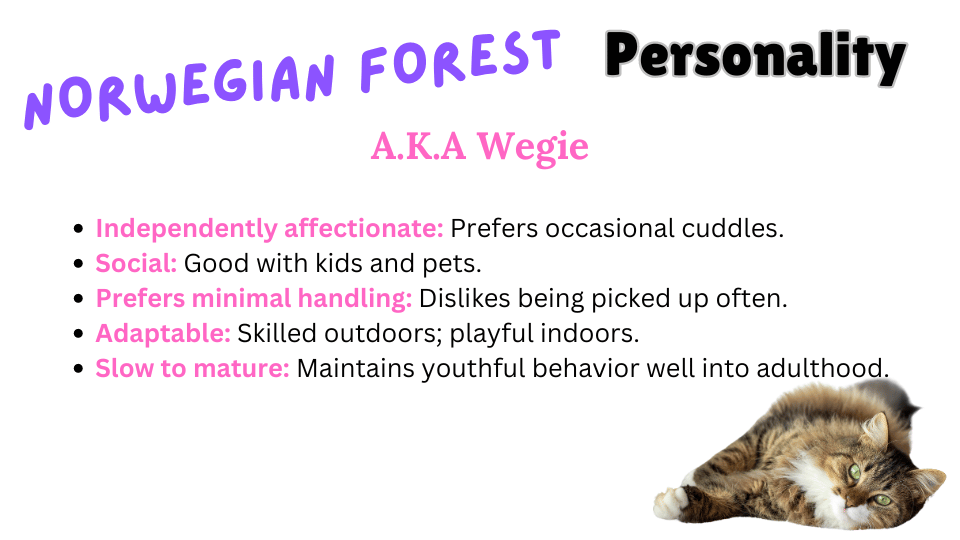
The Norwegian Forest Cat Breed offers a blend of independence and affection that can captivate any cat lover. While they may not be the type to sleep on your lap all night, don’t be surprised if they jump up for a brief cuddle—these cats cherish moments of affection but on their own terms.
Their attachment to family is strong, and they thrive on being involved in every aspect of home life, preferring to stay close rather than be held. Their curious and playful nature makes them excellent companions for families with children, and their mellow temperament allows them to coexist peacefully with well-behaved dogs and other cats.
However, despite their sociable demeanor, they are not fans of being picked up frequently. Their vocal expressions include a range of high-pitched “chirping” sounds, adding to their charming personality.
Norwegian Forest Cats adapt well to both outdoor and indoor settings. In the wild, they are skilled hunters, but indoors, they adjust beautifully, maintaining their playful and curious traits.
Fact: Their slow maturation means they retain kitten-like qualities well into adulthood, which might make them less suitable for extremely active households or homes with frequent visitors, as they can be shy and reserved.
Caring for the Norwegian Forest Cat Breed
The majestic Norwegian Forest Cat, known for its robust build and adventurous spirit, requires specific care to maintain its health and happiness. Let’s dive into the essentials of health management, diet, and exercise for this enchanting breed.
Health Issues
Norwegian Forest Cats typically enjoy a lifespan of 14-16 years. However, like many pedigreed breeds, they are susceptible to certain genetic health issues, which responsible breeders strive to manage:
- Hypertrophic Cardiomyopathy (HCM): The most common heart disease in cats, HCM involves the thickening of the heart walls, which can be diagnosed with regular veterinary screenings.
- Hip Dysplasia: Although less common in cats than dogs, this condition affects some larger breeds like the Norwegian Forest cat, where the looseness of the hip joint can lead to discomfort and mobility issues.
- Glycogen Storage Disease Type IV (GSD IV): This rare genetic disorder is caused by a defective enzyme, leading to severe organ dysfunction and muscle atrophy.
- Pyruvate Kinase Deficiency: This condition leads to hemolytic anemia and is another health concern that can be tested for genetically.
Reputable breeders will monitor their cats’ health rigorously and provide genetic testing to minimize the risk of these diseases. Prospective owners should ensure they obtain their pets from breeders who offer health guarantees and transparent medical histories.
Diet & Nutrition
Norwegian Forest Cats boast a strong build, but keeping them lean is crucial to prevent weight-related health problems such as diabetes, heart disease, and exacerbated hip dysplasia.
To maintain a healthy weight, it’s best to feed your cat measured amounts of high-quality cat food twice a day. Avoid leaving food out throughout the day as free-fed cats tend to overeat, leading to unnecessary weight gain.
A diet that balances proteins, fats, and carbohydrates, tailored to their specific age, weight, and health needs, will keep your Norwegian Forest Cat in optimal health.
Exercise Routine
Norwegian Forest Cats are not excessively active but do enjoy their playful moments, which keep them mentally and physically stimulated well into adulthood. They appreciate engaging toys and are generally ready for a play session on their terms. Providing a cat tree or tower is ideal, especially near a window, as it offers climbing, perching, and scratching opportunities while allowing them to watch the world outside.
If you have outdoor space, securing it with a cat-proof fence or building an enclosed cat run can be beneficial. These features cater to the Norwegian Forest Cat’s proficient climbing abilities, ensuring they enjoy physical activity safely and contentedly.
Fun Fact: Norse legends celebrate the “skogkatt” as a mystical mountain-dwelling fairy cat, renowned for its extraordinary ability to scale sheer rock faces unlike any other cat. Given their impressive climbing skills, some believe these mythical creatures could be the ancestors of today’s Norwegian Forest Cat breed.
Grooming Requirements for the Norwegian Forest Cat
Keeping your Norwegian Forest Cat looking majestic and feeling comfortable requires a few grooming rituals. Here’s a straightforward list to keep your furry friend in top shape:
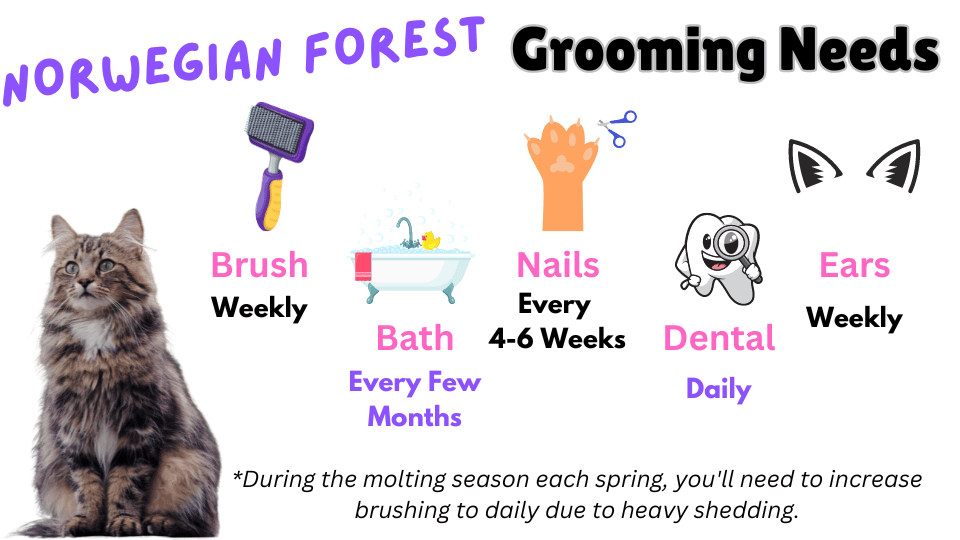
- Brushing: A weekly brushing session helps manage their long, luxurious fur, keeping it smooth and free of tangles.
- Bathing Routine: Bathe your Norwegian Forest Cat every few months to keep their coat fresh and reduce dander. This breed usually tolerates water better than others, thanks to their water-resistant fur.
- Nail Care: Regular nail trims, about every 4-6 weeks, help prevent overgrowth and protect both your cat and your furniture.
- Teeth Cleaning: Ideally, brush your cat’s teeth daily to prevent dental issues, but at a minimum, aim for a few times a week to keep their teeth healthy and gums strong.
- Ear Checks: Weekly inspections of their ears for dirt and signs of infection are crucial. Clean them as needed to prevent any health issues.
Fact: Expect a “molting” period each spring when your cat sheds its undercoat. During this time, increase brushing frequency to daily sessions to handle the heavy shedding and maintain a clean, mat-free coat. A good vacuum will also be indispensable to manage the fur around the house.
Conclusion: Cherishing the Norwegian Forest Cat Breed
Owning a Norwegian Forest Cat is a delightful journey into the world of a breed as resilient as it is charming. These cats combine rugged outdoor instincts with affectionate, family-friendly temperaments. By providing proper care, from regular grooming to managing their unique health needs, you ensure that your Norwegian Forest Cat thrives.
With their fairy-tale origins and impressive stature, bringing a “Wegie” into your home means adding a bit of forest magic to everyday life.
Meet Sean, a fintech whiz with a penchant for pet purrs and blockchain buzz. After a decade of fintech feats, Sean’s tech talents leaped from ledger lines to litter lines, driven by a passion for pets and a vision for a more connected pet care community. With three critter companions as co-pilots, Sean launched this blog to share a treasury of pet-friendly tech tips and tales.

